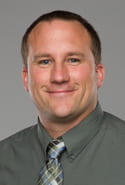January 14, 2014
News release distributed by the University of Wisconsin Water Resources Institute
For more information contact:
Marie Zhuikov (715) 392-3472, mzhuikov@aqua.wisc.edu
Moira Harrington (608) 263-5371, moira@aqua.wisc.edu
Researchers Find Strontium in Northeastern Wisconsin Wells
Although strontium can impact health, water softeners remove most of it
University of Wisconsin Water Resources Institute researchers have discovered strontium in the drinking water of people living in Brown and Outagamie counties near Green Bay, Wis. Not to be confused with the radioactive version that is a byproduct of nuclear fission, this type of strontium is contained within a mineral known as celestine. Strontium dissolves in water and has no taste or odor, and can cause health problems when ingested, especially for children.

The study, by John Luczaj, associate professor in the Department of Natural and Applied Sciences at the University of Wisconsin-Green Bay with UW-Green Bay graduate student Joseph Baeten and Associate Professor Michael Zorn, involved collecting 115 water samples from municipal and private wells in Brown and Outagamie counties.
In preliminary findings, 73 samples (63 percent) contained strontium levels higher than the Environmental Protection Agency’s lifetime Health Advisory Limit of 4 mg/L, which means people drinking the water over the long term face an increased risk for health problems. Six water samples (5 percent) contained levels above 25 mg/L, which exceed the short-term exposure levels identified by the EPA. Children who drink the water for more than between one and 10 days face an increased risk of developing health problems, including tooth enamel mottling and strontium rickets.
The researchers also pinpointed that the source of the strontium is natural. In addition to the water samples analyzed, they examined the chemistry of over 100 rock samples collected during other studies. Their analysis showed the primary source of dissolved strontium in the groundwater originates from celestine and possibly strontianite, another mineral.
“Our study confirms there’s a significant problem in eastern Wisconsin for strontium levels in drinking water,” Luczaj said. “The public needs to be aware of this, and we recommend that a Strontium Advisory Area be established for the region.”
That would be the job of the Wisconsin Department of Health Services. Roy Irving, a toxicologist with the department, said that establishing such an advisory area, “Would make sense from a research perspective if they identified an area that was susceptible to high levels of naturally occurring strontium.” He said a Strontium Advisory Area would function similarly to the Arsenic Advisory Area already established for Outagamie and Winnebago counties, where homeowners are directed to test for arsenic annually and new wells are tested and designed differently to minimize the risk of arsenic in drinking water.
On the periodic table, strontium’s upper and lower neighbors are calcium and barium. Strontium’s similarity to calcium and its behavior in water is what makes this mineral problematic for humans, especially children.
“When children’s tooth enamel and bones are developing, exposure to strontium can cause tooth mottling and strontium rickets,” said Luczaj.
While tooth mottling is mainly a cosmetic issue, causing white spots or brown stains to be deposited on the teeth, rickets can impact bone development and quality of life. The body mistakes strontium for calcium and tries to incorporate it into developing bones. This softens the bones, leading to bowed legs, widened wrists, skull abnormalities, spinal deformities, and an increased likelihood for bone fractures.
According to the Outagamie County Public Health Division, rickets is not a reportable illness, so data on its prevalence is not available.

Although evaluating the distribution and sources of strontium in Brown and Outagamie counties was the focus of the study, the researchers also tested several household samples of water treated with water softeners and found them effective at removing 97 percent of the dissolved strontium. Municipal systems were less effective in removing strontium because they are designed to remove radium. In two municipal samples, 57 percent and 74 percent of strontium were removed.
Luczaj has these suggestions for people in the counties with high strontium: “If they are drinking water-softened water or reverse-osmosis water, there’s probably little strontium in it,” he said. “But if they have young children and they are in the high-strontium area, they should definitely have their water tested.”
Luczaj says testing for strontium costs between $30 and $75, depending on what other chemicals people want included in the test. To find a state-certified water testing laboratory, search the lab lists on the Wisconsin Department of Natural Resources website:
http://dnr.wi.gov/regulations/labCert/LabLists.html.
To learn more, read the Wisconsin Department of Health Service’s “Strontium in Drinking Water” fact sheet. (http://www.dhs.wisconsin.gov/eh/Water/strontium.htm)
###
Conceived in 1964, the Water Resources Research Institute Program is a nationwide network of 54 university-based programs of research, outreach, and education dedicated to solving state, regional and national water resource problems. The program is a state-federal partnership supported with funding from each state and the U.S. Geological Survey, U.S. Department of the Interior. Additional funding for the University of Wisconsin Water Resources Institute is provided by the Wisconsin Groundwater Research and Monitoring Program. wri.wisc.edu

